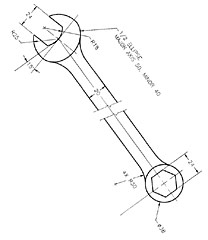Turbo charging
Introduction
According to Holset: "A turbocharger is a mechanical device which uses the engine’s exhaust gases to force more air into the engine
cylinders. Hot exhaust gas energy is used to turn a turbine wheel and shaft. At the other end of the shaft is the
compressor impeller (or compressor wheel), which draws in air and forces it into the engine cylinders.
Supplying increased air mass flow to the engine provides improved engine performance, lower exhaust smoke
density, improved operating economy and altitude compensation. The turbocharger has proven to be one of the
most beneficial devices for improving engine performance".
Contents
Instructions for mod
To start down this long road the best thing you can do is do some internet searching and see if other people are having good results to turbo charging a vehicle like yours. If your engine and drivetrain have the room to install a turbo charger and all the piping that goes with it and your drive train is able to handle the added power then you can get started. If you happen to have a vehicle that is commonly turbocharged by gear heads or has a factory turbo option, finding the parts and basic info you will need will be a lot easier.
Turbocharger kits: There are a lot of premade after market kits out there. Most of the time these are going to be put together with power in mind and above all else. These aftermarket manufactures can give you a good starting point and a source for many non factory parts.
Turbocharger take offs: If you are lucky you may have the option to get a used and very cheap factory turbo charger set up for your vehicle out of something at a near by junk yard. You may be able to use some or all of the parts that fit your vehicle. It could make a very good starting point. Factory turbochargers are usually set up to maximize all around drive ability and durability, more inline with the goals of an ecomodder.
Turbocharger ecomodding: For a diesel this is not hard to do. If you can attach a turbo charger roughly the correct size to a diesel engine you will have no problem seeing an improvement. The gasoline engine is a little different. Too big and the turbo charger will just act as a restriction when trying to cruise down the high way. If you size your turbo too small it will not run efficiently at cruise and with too small of a turbine housing will act as a restriction when under load. Most turbo upgrade applications will require people to lower there compression ratio. The eccomodder turbo install would be on the mild performance side of things and likely would not require a change in compression ratio unless your engine ran unusually high compression from the factory. See the compression ratio wiki for reasons why you may want to try and retain a higher compression ratio. Ecoturbocharging will likely require some minimal fuel system upgrades if the modder is able to control him or her self concerning horsepower levels.
User experiences
| User Name | Car Make, Model, Year | Cost of Mod | Time to Perform Mod | Driving conditions | MPG Before Mod | MPG After Mod | MPG improvement guess | Instruction Link |
|---|---|---|---|---|---|---|---|---|
| oil pan 4 | 1984 chevy diesel suburban | $1600 total | 40+hr | all highway, pulling trailer | 21mpg highway | 25mpg highway | About 15% | User mod detail or measurement detailed data |
| oil pan 4 | same | same | same | Mixed city driving | 16.2 | 18.8 | 12% | User mod detail or measurement detailed data |
Problems / Consequences of mod
Your engine performance will be greatly impacted by turbocharging. Most of it good, but not with out a few problems. As your boost increases and more fuel is dumped into the engine and you need to have a way to retard the ignition timing on gassers (a diesel engine does not care). When mounting the intercooler it may block air flow to the radiator. The added power and obstructive intercooler may require you to install a larger radiator and upgrade the engine cooling system. When a turbo is installed on a gas engine normally people will need to switch to premium gas, a diesel enigne will still run fine off the same fuel as before. The turbocharger hot side piping can cause wires and lines to burn if not protected or relocated. Turbochargers require oil. You will need to run a pressurized line from the engine to the turbo and install a return line to the oil pan. All too often turbocharging requires the vehicles battery to be relocated or some times the A/C system needs to be removed to make room for the added piping.
References
Forum thread links
1996 diesel land cruiser, goes twin turbo
